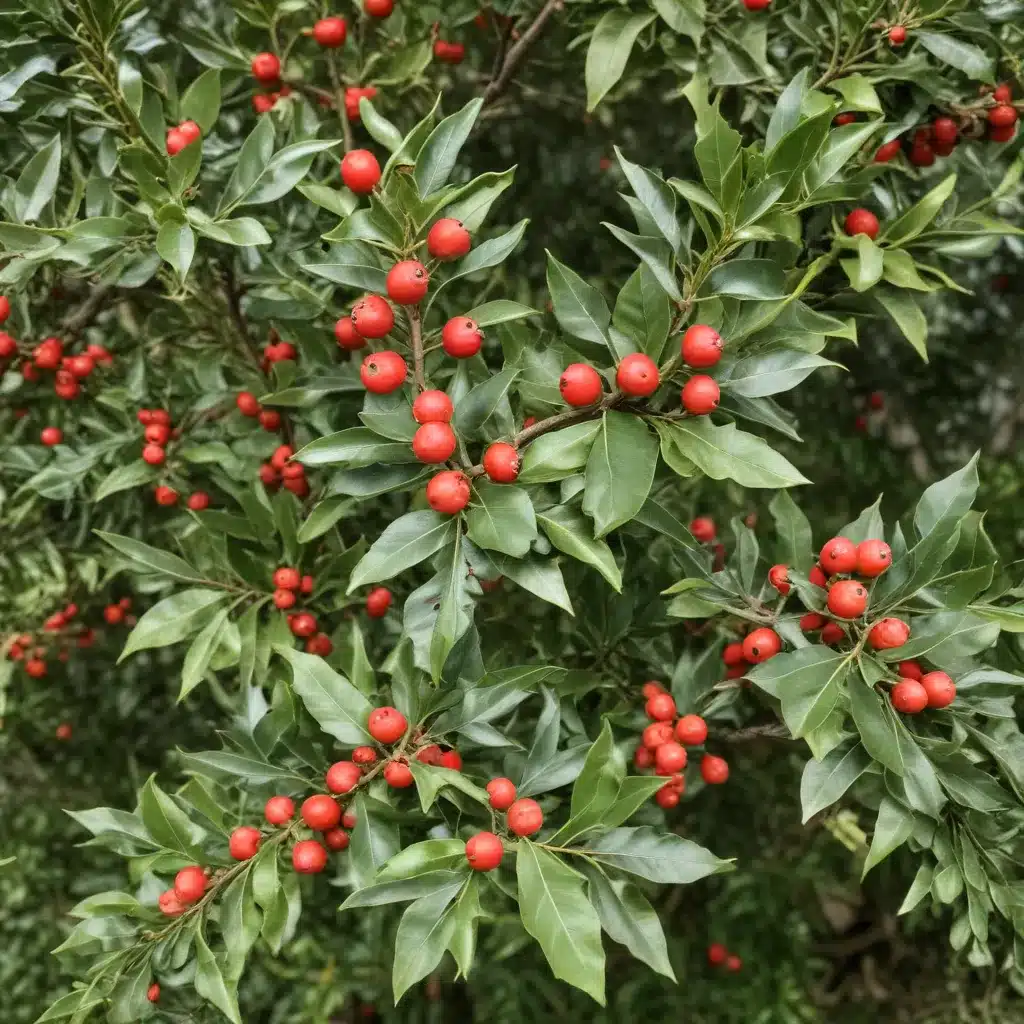
The Yaupon Holly (Ilex vomitoria) is a captivating evergreen shrub or small tree native to the southeastern United States, boasting a rich history and a multitude of fascinating attributes. As a tree care specialist with TriCounty Tree Care, I am delighted to share an in-depth exploration of this remarkable species, shedding light on its botanical characteristics, ecological significance, culinary and medicinal applications, as well as its profound cultural and historical relevance.
Botanical Characteristics
The Yaupon Holly belongs to the Aquifoliaceae family, closely related to the familiar English Holly (Ilex aquifolium). This hardy, drought-tolerant plant can grow up to 30 feet (9 meters) in height, though it is more commonly encountered as a dense, multi-stemmed shrub reaching 10-15 feet (3-4.5 meters) tall. The glossy, evergreen leaves of the Yaupon Holly are elliptical to oblong in shape, measuring 1-2 inches (2.5-5 cm) in length. These leathery, spoon-shaped leaves display a distinctive serrated margin, adding to the plant’s striking visual appeal.
The stem structure of the Yaupon Holly is characterized by smooth, gray-brown bark that becomes fissured with age. The branches are slender and flexible, often with a slightly pendulous habit. During the spring months, the plant produces an abundance of small, creamy-white flowers arranged in clusters along the stems. These delicate blooms give way to bright red berries in the fall, providing a vibrant contrast against the lustrous foliage.
Ecological Considerations
The native range of the Yaupon Holly extends from southeastern Virginia, along the coastal plains and piedmont regions, down to central Florida and across to eastern Texas. This resilient species thrives in a variety of habitats, including maritime forests, coastal scrubs, sandy upland woods, and even disturbed areas such as roadsides and urban landscapes.
The Yaupon Holly’s adaptations to its environment are truly remarkable. Its drought-tolerant nature and ability to tolerate a wide range of soil conditions, from sandy to clay-based, allow it to flourish in areas where many other plants would struggle. Additionally, the plant’s evergreen foliage and capacity to resprout from the base after damage or disturbance contribute to its remarkable resilience.
In its native ecosystems, the Yaupon Holly plays a vital role, serving as a food source and shelter for a diverse array of wildlife. Its bright red berries are a cherished delicacy for birds, while its dense, tangled growth provides nesting sites and protective cover for small mammals and avian species. The plant’s symbiotic relationships with certain fungi and bacteria in the soil also contribute to the overall health and vitality of the surrounding ecosystem.
Culinary and Medicinal Uses
One of the most captivating aspects of the Yaupon Holly is its long-standing history of culinary and medicinal applications. The plant’s leaves and young shoots have been used for centuries by Indigenous peoples, such as the Caddo, Choctaw, and Seminole, as a source of caffeinated tea. This traditional beverage, known as “black drink,” was an integral part of cultural ceremonies and social gatherings.
The caffeine content in Yaupon Holly leaves, derived from the compound theobromine, provides a gentle, sustained energy boost without the jittery effects often associated with coffee. Furthermore, the plant’s leaves are rich in antioxidants, vitamins, and minerals, making Yaupon tea a healthful and rejuvenating beverage choice.
In addition to its culinary uses, the Yaupon Holly has a storied medicinal history. Indigenous communities have long utilized various parts of the plant to treat a wide range of ailments, from digestive issues to respiratory problems. The plant’s anti-inflammatory properties have also been recognized, and it has been used to alleviate symptoms associated with conditions such as arthritis and gout.
Cultural and Historical Significance
The Yaupon Holly holds a revered place in the cultural and historical tapestry of the southeastern United States. For many Indigenous nations, the plant has been a sacred and ceremonial element for millennia, woven into the fabric of their traditions and beliefs.
In the pre-Columbian era, the black drink ceremony, involving the consumption of Yaupon tea, was a pivotal ritual among certain tribes. This practice was not only a means of social and spiritual bonding but also served as a purification rite, with the plant’s emetic properties playing a central role.
Beyond its ceremonial significance, the Yaupon Holly has also been symbolically represented in the mythology and artwork of various Indigenous cultures. The plant’s evergreen nature and its ability to thrive in diverse environments have led to its association with resilience, longevity, and adaptability – qualities highly valued in these traditions.
In more recent history, the Yaupon Holly has continued to capture the imagination of the general public. Its unique flavor profile and health benefits have contributed to a growing interest in the plant, with a surge in the popularity of Yaupon tea and other Yaupon-based products. As awareness of the plant’s ecological and cultural importance increases, the Yaupon Holly is poised to assume an even more prominent role in the collective consciousness of the region.
Whether you are a nature enthusiast, a tea connoisseur, or simply someone captivated by the rich tapestry of regional history and traditions, the Yaupon Holly is a plant that is truly worthy of your attention. Its distinctive characteristics, ecological significance, and cultural legacy make it a remarkable addition to the natural world. To learn more about the care and cultivation of this exceptional plant, I invite you to explore the resources and services offered by TriCounty Tree Care.


